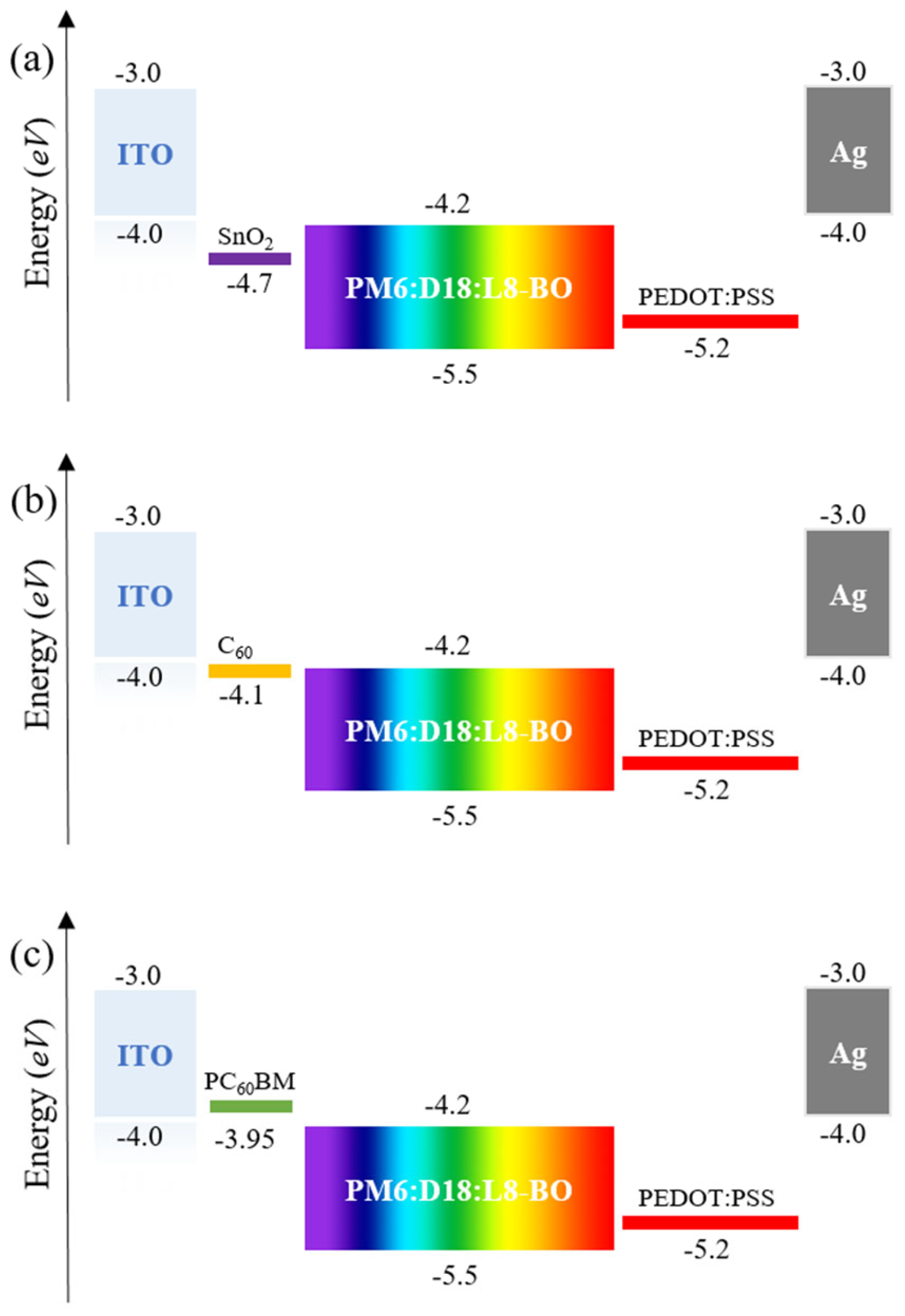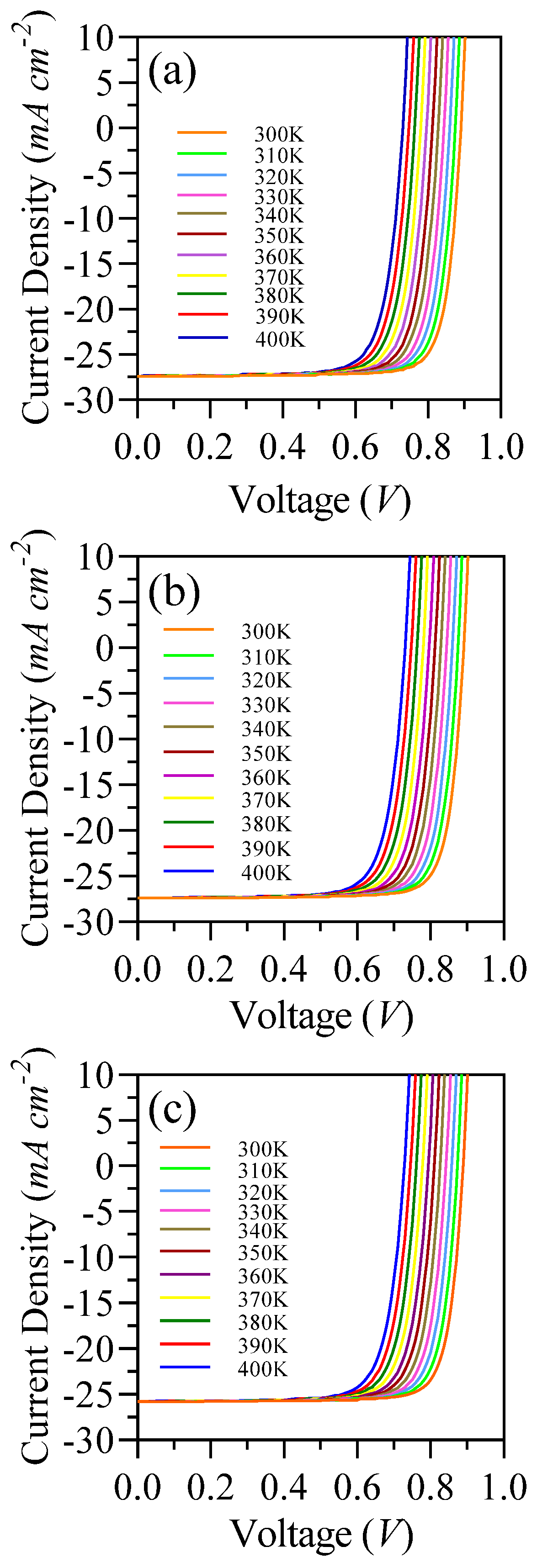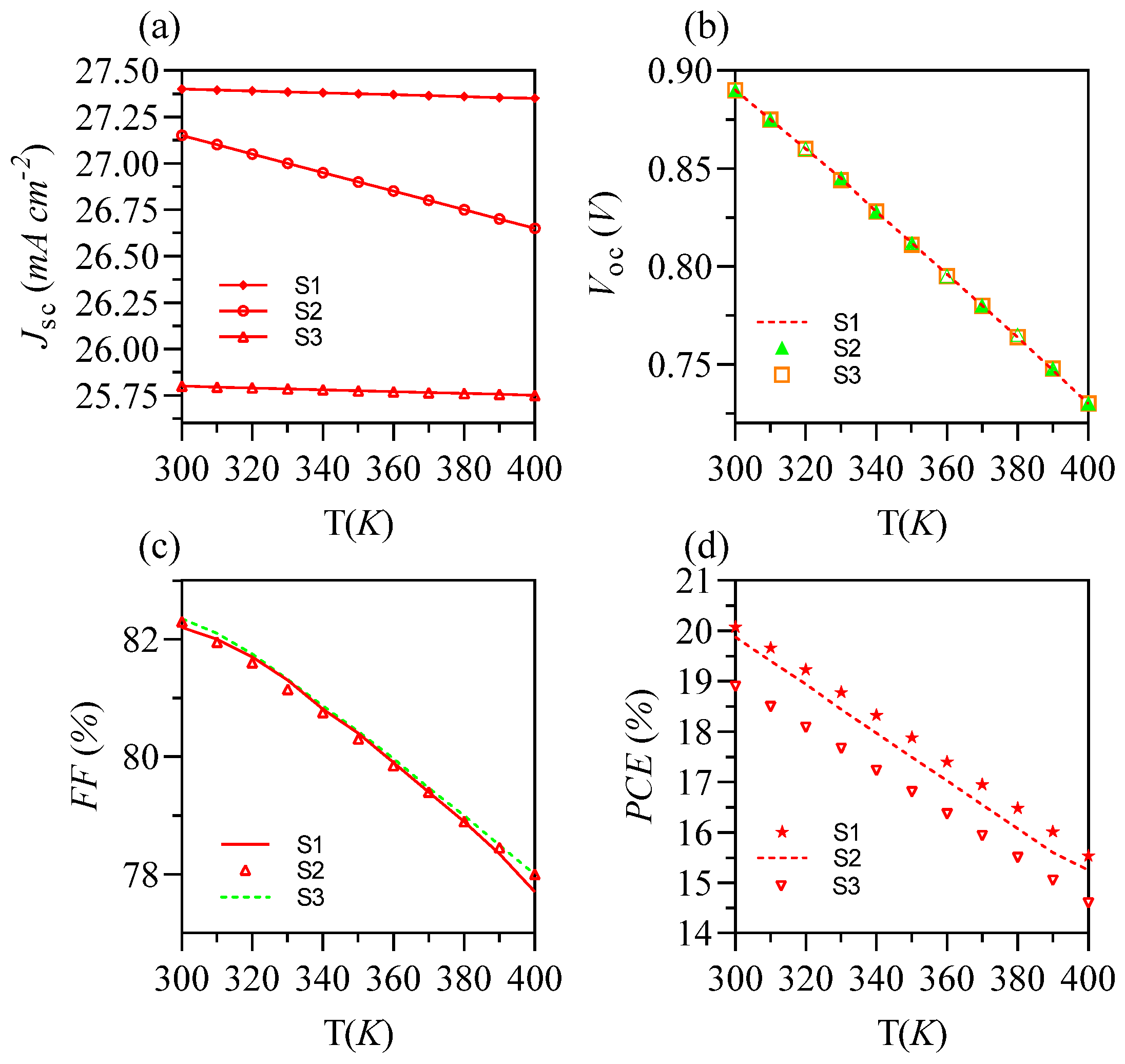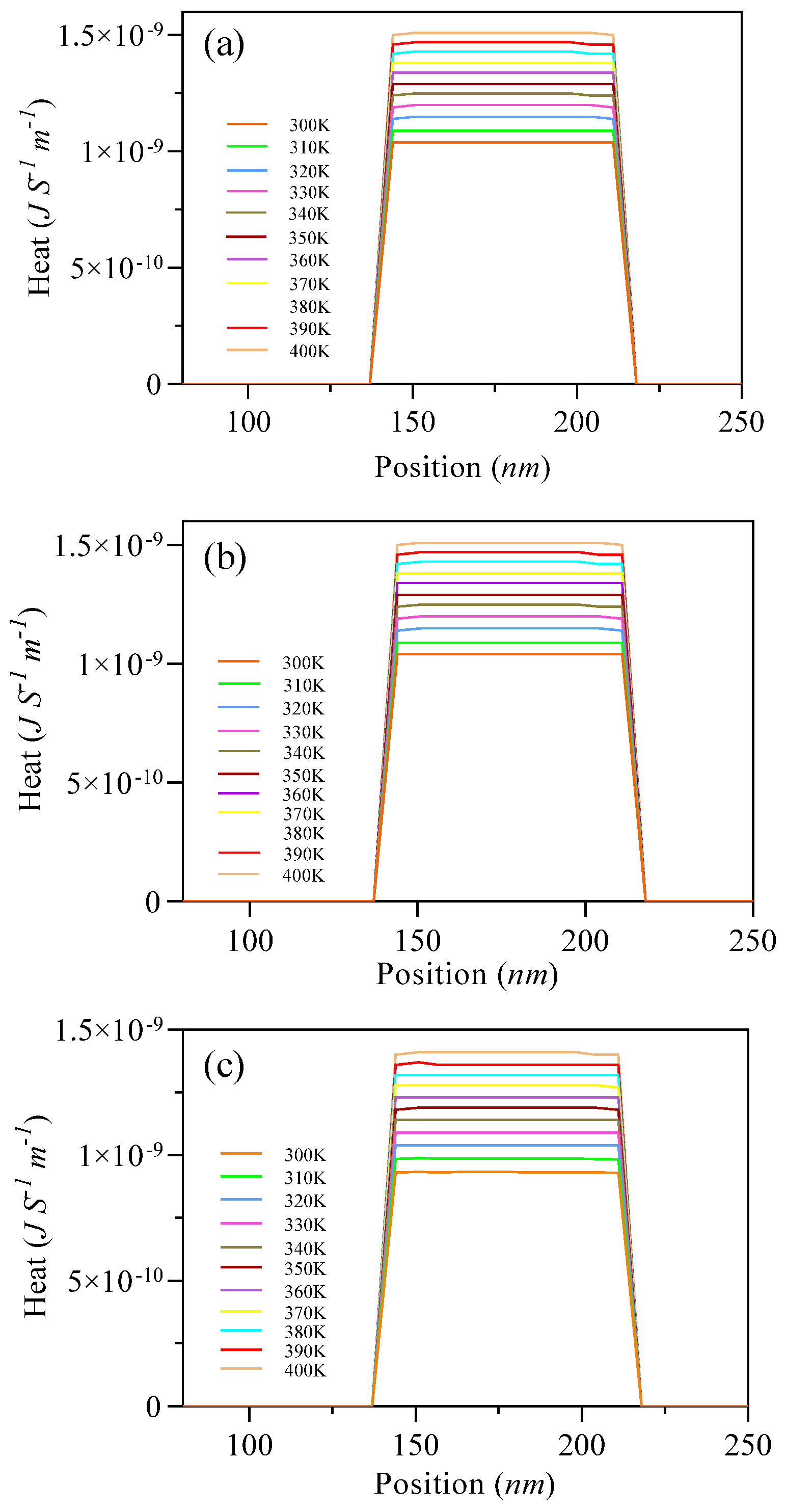Highly Stable Inverted Organic Solar Cell Structure Using Three Efficient Electron Transport Layers
Abstract
1. Introduction
2. The Simulation Model and Performance Indicators
3. Results and Discussion
4. Conclusions
Author Contributions
Funding
Data Availability Statement
Conflicts of Interest
Nomenclature
| Symbol | Description | Unit |
| q | Electrical charge | C |
| n | Concentration of free electrons | m−3 |
| n0 | Equilibrium density of electron | m−3 |
| Nc,v | Effective density of states in the conduction band | m−3 |
| p0 | Equilibrium density of holes | m−3 |
| P | Concentration of free holes | m−3 |
| Jn,p | Current density of electrons and holes | Am−2 |
| vth | Thermal emission velocity of the carriers | ms−1 |
| Ec,v | Conduction and valence band | eV |
| EF,h,e | Energy-corresponding Fermi level | eV |
| Fn,p | Fermi level in the conduction and valence band | eV |
| Dn,p | Diffusion coefficient of electrons and holes | m2 s−1 |
| Rn | Recombination rate of electrons | s⁻1 |
| Rp | Recombination rate of holes | s⁻1 |
| G | Carrier generation rate | s⁻1 |
| KB | Boltzmann constant | JK⁻1 |
| k | Rate constant of the reaction | |
| T | Temperature | K |
| Greek Symbols | ||
| Permittivity of free space | Fm−1 | |
| Relative permittivity | Fm−1 | |
| φ | Voltage profile | V |
| µe,h | Electron and hole mobility | m2 V−1 s−1 |
| ΔE | Energy offset | % |
| ω | Angular frequency of the wave | rad s−1 |
| λ | Wavelength | nm |
| Superscripts | ||
| D | Electron donor | |
| A | Electron acceptor | |
References
- Coyle, E.D.; Simmons, R.A. (Eds.) Introduction. In Understanding the Global Energy Crisis; Purdue University Press: West Lafayette, IN, USA, 2014; pp. 1–8. Available online: http://www.jstor.org/stable/j.ctt6wq56p.5 (accessed on 15 November 2023).
- Melin, H. Towards a solution to the energy crisis. Nat. Astron. 2020, 4, 837–838. [Google Scholar] [CrossRef]
- Mhlanga, D.; Ndhlovu, E. The Implications of the Russia–Ukraine War on Sustainable Development Goals in Africa. Fudan J. Humanit. Soc. Sci. 2023, 16, 435–454. [Google Scholar] [CrossRef]
- Borowski, P.F. Mitigating Climate Change and the Development of Green Energy versus a Return to Fossil Fuels due to the Energy Crisis in 2022. Energies 2022, 15, 9289. [Google Scholar] [CrossRef]
- Burney, J.A. The downstream air pollution impacts of the transition from coal to natural gas in the United States. Nat. Sustain. 2020, 3, 152–160. [Google Scholar] [CrossRef]
- Guan, Y.; Yan, J.; Shan, Y.; Zhou, Y.; Hang, Y.; Li, R.; Liu, Y.; Liu, B.; Nie, Q.; Bruckner, B.; et al. Burden of the global energy price crisis on households. Nat. Energy 2023, 8, 304–316. [Google Scholar] [CrossRef]
- Creutzig, F. Fuel crisis: Slash demand in three sectors to protect economies and climate. Nature 2022, 606, 460–462. [Google Scholar] [CrossRef]
- Parag, Y.; Fawcett, T.; Hampton, S.; Eyre, N. Energy saving in a hurry: A research agenda and guidelines to study European responses to the 2022–2023 energy crisis. Energy Res. Soc. Sci. 2023, 97, 102999. [Google Scholar] [CrossRef]
- The politics of energy security. Nat. Energy 2023, 8, 1047. [CrossRef]
- Frilingou, N.; Xexakis, G.; Koasidis, K.; Nikas, A.; Campagnolo, L.; Delpiazzo, E.; Chiodi, A.; Gargiulo, M.; McWilliams, B.; Koutsellis, T.; et al. Navigating through an energy crisis: Challenges and progress towards electricity decarbonisation, reliability, and affordability in Italy. Energy Res. Soc. Sci. 2023, 96, 102934. [Google Scholar] [CrossRef]
- Ingram, T.; Wieczorek-Kosmala, M.; Hlaváček, K. Organizational Resilience as a Response to the Energy Crisis: Systematic Literature Review. Energies 2023, 16, 702. [Google Scholar] [CrossRef]
- Hunt, J.D.; Stilpen, D.; de Freitas, M.A.V. A review of the causes, impacts and solutions for electricity supply crises in Brazil. Renew. Sustain. Energy Rev. 2018, 88, 208–222. [Google Scholar] [CrossRef]
- Wuebbles, D.J.; Fahey, D.W.; Hibbard, K.A. Climate Science Special Report: Fourth National Climate Assessment, Volume I; U.S. Global Change Research Program: Washington, DC, USA, 2017. [CrossRef]
- Klingelhöfer, D.; Müller, R.; Braun, M.; Brüggmann, D.; Groneberg, D.A. Climate change: Does international research fulfill global demands and necessities? Environ. Sci. Eur. 2020, 32, 137. [Google Scholar] [CrossRef] [PubMed]
- Welsby, D.; Price, J.; Pye, S.; Ekins, P. Unextractable fossil fuels in a 1.5 °C world. Nature 2021, 597, 230–234. [Google Scholar] [CrossRef]
- Kroeger, C. Heat is associated with short-term increases in household food insecurity in 150 countries and this is mediated by income. Nat. Hum. Behav. 2023, 7, 1777–1786. [Google Scholar] [CrossRef] [PubMed]
- Guivarch, C.; Le Gallic, T.; Bauer, N.; Fragkos, P.; Huppmann, D.; Jaxa-Rozen, M.; Keppo, I.; Kriegler, E.; Krisztin, T.; Marangoni, G.; et al. Using large ensembles of climate change mitigation scenarios for robust insights. Nat. Clim. Chang. 2022, 12, 428–435. [Google Scholar] [CrossRef]
- Achakulwisut, P.; Erickson, P.; Guivarch, C.; Schaeffer, R.; Brutschin, E.; Pye, S. Global fossil fuel reduction pathways under different climate mitigation strategies and ambitions. Nat. Commun. 2023, 14, 5425. [Google Scholar] [CrossRef] [PubMed]
- Kemfert, C.; Präger, F.; Braunger, I.; Hoffart, F.M.; Brauers, H. The expansion of natural gas infrastructure puts energy transitions at risk. Nat. Energy 2022, 7, 582–587. [Google Scholar] [CrossRef]
- Masson, V.; Bonhomme, M.; Salagnac, J.-L.; Briottet, X.; Lemonsu, A. Solar panels reduce both global warming and urban heat island. Front. Environ. Sci. 2014, 2, 14. [Google Scholar] [CrossRef]
- Dunne, N.A.; Liu, P.; Elbarghthi, A.F.A.; Yang, Y.; Dvorak, V.; Wen, C. Performance evaluation of a solar photovoltaic-thermal (PV/T) air collector system. Energy Convers. Manag. X 2023, 20, 100466. [Google Scholar] [CrossRef]
- Nijsse, F.J.M.M.; Mercure, J.F.; Ameli, N.; Larosa, F.; Kothari, S.; Rickman, J.; Vercoulen, P.; Pollitt, H. The momentum of the solar energy transition. Nat. Commun. 2023, 14, 6542. [Google Scholar] [CrossRef] [PubMed]
- Kalyani, N.T.; Dhoble, S.J. Chapter 10—Empowering the Future With Organic Solar Cell Devices. In Nanomaterials for Green Energy; Bhanvase, B.A., Pawade, V.B., Dhoble, S.J., Sonawane, S.H., Ashokkumar, M., Eds.; Micro and Nano Technologies; Elsevier: Amsterdam, The Netherlands, 2018; pp. 325–350. [Google Scholar] [CrossRef]
- Chen, L.X. Organic Solar Cells: Recent Progress and Challenges. ACS Energy Lett. 2019, 4, 2537–2539. [Google Scholar] [CrossRef]
- Lee, D.; Kim, J.; Park, G.; Bae, H.W.; An, M.; Kim, J.Y. Enhanced Operating Temperature Stability of Organic Solar Cells with Metal Oxide Hole Extraction Layer. Polymers 2020, 12, 992. [Google Scholar] [CrossRef]
- Cheng, P.; Zhan, X. Stability of organic solar cells: Challenges and strategies. Chem. Soc. Rev. 2016, 45, 2544–2582. [Google Scholar] [CrossRef]
- Duan, L.; Uddin, A. Progress in Stability of Organic Solar Cells. Adv. Sci. 2020, 7, 1903259. [Google Scholar] [CrossRef] [PubMed]
- Yang, W.; Wang, W.; Wang, Y.; Sun, R.; Guo, J.; Li, H.; Shi, M.; Guo, J.; Wu, Y.; Wang, T.; et al. Balancing the efficiency, stability, and cost potential for organic solar cells via a new figure of merit. Joule 2021, 5, 1209–1230. [Google Scholar] [CrossRef]
- Zhang, C.; Ming, S.; Wu, H.; Wang, X.; Huang, H.; Xue, W.; Xu, X.; Tang, Z.; Ma, W.; Bo, Z. High-efficiency ternary nonfullerene organic solar cells with record long-term thermal stability. J. Mater. Chem. A 2020, 8, 22907–22917. [Google Scholar] [CrossRef]
- Xu, X.; Fukuda, K.; Karki, A.; Park, S.; Kimura, H.; Jinno, H.; Watanabe, N.; Yamamoto, S.; Shimomura, S.; Kitazawa, D.; et al. Thermally stable, highly efficient, ultraflexible organic photovoltaics. Proc. Natl. Acad. Sci. USA 2018, 115, 4589–4594. [Google Scholar] [CrossRef] [PubMed]
- Wang, X.; Feng, J.; Zhang, Z.; Xing, J.; Li, W.; Cui, Y.; Wu, Z.; Yu, W.; Chen, L. Gelation of Electron Transport Layer to Improve the Thermal Stability of Efficient Perovskite Solar Cells. J. Mater. Chem. C Mater. 2024, 12, 14433–14444. [Google Scholar] [CrossRef]
- Mbilo, M.; Haris, M.; Ryu, D.H.; Mwabora, J.M.; Musembi, R.J.; Lee, S.; Song, C.E.; Shin, W.S. Improved Light Soaking and Thermal Stability of Organic Solar Cells by Robust Interfacial Modification. Adv. Energy Sustain. Res. 2024, 5, 2300210. [Google Scholar] [CrossRef]
- Di Mario, L.; Garcia Romero, D.; Wang, H.; Tekelenburg, E.K.; Meems, S.; Zaharia, T.; Portale, G.; Loi, M.A. Outstanding Fill Factor in Inverted Organic Solar Cells with SnO2 by Atomic Layer Deposition. Adv. Mater. 2024, 36, 2301404. [Google Scholar] [CrossRef]
- Proctor, C.M.; Kuik, M.; Nguyen, T.Q. Charge carrier recombination in organic solar cells. Prog. Polym. Sci. 2013, 38, 1941–1960. [Google Scholar] [CrossRef]
- Xu, W.; Yi, C.; Yao, X.; Jiang, L.; Gong, X.; Cao, Y. Efficient Organic Solar Cells with Polymer-Small Molecule: Fullerene Ternary Active Layers. ACS Omega 2017, 2, 1786–1794. [Google Scholar] [CrossRef] [PubMed]
- Golubev, T.; Liu, D.; Lunt, R.; Duxbury, P. Understanding the impact of C60 at the interface of perovskite solar cells via drift-diffusion modeling. AIP Adv. 2019, 9, 35026. [Google Scholar] [CrossRef]
- El Karkri, A.; El Malki, Z.; Bouachrine, M.; Serein-Spirau, F.; Sotiropoulos, J.-M. Characterization and simulation study of organic solar cells based on donor–acceptor (D–π–A) molecular materials. RSC Adv. 2020, 10, 18816–18823. [Google Scholar] [CrossRef]
- Khan, M.R.; Jarząbek, B. Optimization and Efficiency Enhancement of Modified Polymer Solar Cells. preprints 2023. [Google Scholar] [CrossRef]
- Anrango-Camacho, C.; Pavón-Ipiales, K.; Frontana-Uribe, B.A.; Palma-Cando, A. Recent Advances in Hole-Transporting Layers for Organic Solar Cells. Nanomaterials 2022, 12, 443. [Google Scholar] [CrossRef]
- Tang, H.; Bai, Y.; Zhao, H.; Qin, X.; Hu, Z.; Zhou, C.; Huang, F.; Cao, Y. Interface Engineering for Highly Efficient Organic Solar Cells. Adv. Mater. 2024, 36, 2212236. [Google Scholar] [CrossRef]
- Niederhausen, J.; Mazzio, K.A.; MacQueen, R.W. Inorganicorganic interfaces in hybrid solar cells. Electron. Struct. 2021, 3, 33002. [Google Scholar] [CrossRef]
- Kong, T.; Wang, R.; Zheng, D.; Yu, J. Modification of the SnO2 Electron Transporting Layer by Using Perylene Diimide Derivative for Efficient Organic Solar Cells. Front. Chem. 2021, 9, 703561. [Google Scholar] [CrossRef]
- Eliwi, A.A.; Byranvand, M.M.; Fassl, P.; Khan, M.R.; Hossain, I.M.; Frericks, M.; Ternes, S.; Abzieher, T.; Schwenzer, J.A.; Mayer, T.; et al. Optimization of SnO2 electron transport layer for efficient planar perovskite solar cells with very low hysteresis. Mater. Adv. 2022, 3, 456–466. [Google Scholar] [CrossRef]
- Zhu, L.; Zhang, M.; Xu, J.; Li, C.; Yan, J.; Zhou, G.; Zhong, W.; Hao, T.; Song, J.; Xue, X.; et al. Single-junction organic solar cells with over 19% efficiency enabled by a refined double-fibril network morphology. Nat. Mater. 2022, 21, 656–663. [Google Scholar] [CrossRef]
- Manual: OghmaNano—Organic and Hybrid Material Nano Simulation Tool. Available online: https://www.oghma-nano.com/docs.html?page=Manual (accessed on 6 December 2023).
- MacKenzie, R.C.I.; Shuttle, C.G.; Dibb, G.F.; Treat, N.; von Hauff, E.; Robb, M.J.; Hawker, C.J.; Chabinyc, M.L.; Nelson, J. Interpreting the Density of States Extracted from Organic Solar Cells Using Transient Photocurrent Measurements. J. Phys. Chem. C 2013, 117, 12407–12414. [Google Scholar] [CrossRef]
- Deschler, F.; Riedel, D.; Ecker, B.; von Hauff, E.; Da Como, E.; MacKenzie, R.C.I. Increasing organic solar cell efficiency with polymer interlayers. Phys. Chem. Chem. Phys. 2013, 15, 764–769. [Google Scholar] [CrossRef] [PubMed]
- MacKenzie, R.C.I.; Shuttle, C.G.; Chabinyc, M.L.; Nelson, J. Extracting Microscopic Device Parameters from Transient Photocurrent Measurements of P3HT:PCBM Solar Cells. Adv. Energy Mater. 2012, 2, 662–669. [Google Scholar] [CrossRef]
- Farooq, W.; Khan, A.D.; Khan, A.D.; Noman, M. Enhancing the power conversion efficiency of organic solar cells. Optik 2020, 208, 164093. [Google Scholar] [CrossRef]






| Materials | Tg (K) | Electron Mobility (m2 v−1 s−1) |
|---|---|---|
| SnO2 | 473–573 | 2 × 10−9 |
| C60 | 393–403 | 1.2 × 10−7 |
| PC60BM | 430 | 2 × 10−7 |
| Parameters | Values | Ref. |
|---|---|---|
| Electron mobility (μe) | 1.49 × 10−7 m−2V−1s−1 | [44] |
| Hole mobility (μh) | 1.42 × 10−7 m−2V−1s−1 | [44] |
| Effective density of free electron (Nc at 300 K) | 1 × 1026 m−3 | [44] |
| Effective density of free hole (Nv at 300 K) | 1 × 1026 m−3 | [44] |
| n to P recombination rate constant | 1.15 × 10−17 m−3s−1 | [44] |
| Free electron (n) to trapped electron (strap) | 1 × 10−15 m−2 | [44] |
| Trapped electron (ntrap) to free hole (P) | 1 × 10−20 m−2 | [44] |
| Trapped hole (Ptrap) to free electron (n) | 1 × 10−20 m−2 | [44] |
| Free hole (P) to trapped hole (Ptrap) | 1 × 10−15 m−2 | [44] |
| Number of traps (Nt) | 5 Traps | [44] |
| Energy bandgap (Eg) | 1.29 eV | [44] |
| Relative permittivity (Ɛr) | 3.0 a.u | [44] |
| Layer | Thickness (nm) | Materials | Type |
|---|---|---|---|
| ITO | 130 | Oxides | Contact |
| SnO2 | 5 | Oxides | ETL |
| C60 | 5 | Small molecules | ETL |
| PC60BM | 5 | Polymers | ETL |
| PM6:D18:L8-BO (0.8:0.2:1.2) | 80 | Blends | Active |
| PEDOT: PSS | 20 | Polymers | HTL |
| Ag | 100 | Metal | Contact |
| T (K) | T (°C) | Jsc (mA cm−2) | Voc (V) | FF (%) | PCE (%) | |
|---|---|---|---|---|---|---|
| S1 | 300 | 26.85 | 27.4 | 0.89 | 82.2 | 20.08 |
| 310 | 36.85 | 27.4 | 0.875 | 81.97 | 19.66 | |
| 320 | 46.85 | 27.4 | 0.86 | 81.63 | 19.23 | |
| 330 | 56.85 | 27.4 | 0.84 | 81.26 | 18.78 | |
| 340 | 66.85 | 27.38 | 0.828 | 80.82 | 18.33 | |
| 350 | 76.85 | 27.38 | 0.812 | 80.4 | 17.88 | |
| 360 | 86.85 | 27.37 | 0.796 | 79.91 | 17.4 | |
| 370 | 96.85 | 27.37 | 0.78 | 79.38 | 16.95 | |
| 380 | 106.85 | 27.36 | 0.76 | 78.9 | 16.48 | |
| 390 | 116.85 | 27.36 | 0.747 | 78.35 | 16.01 | |
| 400 | 126.85 | 27.35 | 0.73 | 77.7 | 15.53 | |
| S2 | 300 | 26.85 | 27.15 | 0.89 | 82.3 | 19.88 |
| 310 | 36.85 | 27.05 | 0.875 | 82 | 19.40 | |
| 320 | 46.85 | 27.05 | 0.86 | 81.6 | 18.94 | |
| 330 | 56.85 | 27.03 | 0.84 | 81.2 | 18.44 | |
| 340 | 66.85 | 26.80 | 0.83 | 80.8 | 17.97 | |
| 350 | 76.85 | 26.85 | 0.81 | 80.4 | 17.49 | |
| 360 | 86.85 | 26.65 | 0.8 | 79.9 | 17.03 | |
| 370 | 96.85 | 26.67 | 0.78 | 79.4 | 16.55 | |
| 380 | 106.85 | 26.80 | 0.76 | 78.9 | 16.07 | |
| 390 | 116.85 | 26.57 | 0.75 | 78.3 | 15.60 | |
| 400 | 126.85 | 26.78 | 0.73 | 78 | 15.25 | |
| S3 | 300 | 26.85 | 25.8 | 0.89 | 82.36 | 18.9 |
| 310 | 36.85 | 25.8 | 0.87 | 82 | 18.5 | |
| 320 | 46.85 | 25.8 | 0.86 | 81.7 | 18.08 | |
| 330 | 56.85 | 25.79 | 0.84 | 81.32 | 17.67 | |
| 340 | 66.85 | 25.79 | 0.83 | 80.87 | 17.23 | |
| 350 | 76.85 | 25.78 | 0.81 | 80.43 | 16.81 | |
| 360 | 86.85 | 25.78 | 0.79 | 79.97 | 16.37 | |
| 370 | 96.85 | 25.77 | 0.78 | 79.43 | 15.93 | |
| 380 | 106.85 | 25.77 | 0.76 | 79 | 15.5 | |
| 390 | 116.85 | 25.77 | 0.75 | 78.4 | 15.05 | |
| 400 | 126.85 | 25.76 | 0.73 | 78 | 14.6 |
Disclaimer/Publisher’s Note: The statements, opinions and data contained in all publications are solely those of the individual author(s) and contributor(s) and not of MDPI and/or the editor(s). MDPI and/or the editor(s) disclaim responsibility for any injury to people or property resulting from any ideas, methods, instructions or products referred to in the content. |
© 2025 by the authors. Licensee MDPI, Basel, Switzerland. This article is an open access article distributed under the terms and conditions of the Creative Commons Attribution (CC BY) license (https://creativecommons.org/licenses/by/4.0/).
Share and Cite
Boudia, M.E.A.; Zhao, C. Highly Stable Inverted Organic Solar Cell Structure Using Three Efficient Electron Transport Layers. Energies 2025, 18, 167. https://doi.org/10.3390/en18010167
Boudia MEA, Zhao C. Highly Stable Inverted Organic Solar Cell Structure Using Three Efficient Electron Transport Layers. Energies. 2025; 18(1):167. https://doi.org/10.3390/en18010167
Chicago/Turabian StyleBoudia, Mohamed El Amine, and Cunlu Zhao. 2025. "Highly Stable Inverted Organic Solar Cell Structure Using Three Efficient Electron Transport Layers" Energies 18, no. 1: 167. https://doi.org/10.3390/en18010167
APA StyleBoudia, M. E. A., & Zhao, C. (2025). Highly Stable Inverted Organic Solar Cell Structure Using Three Efficient Electron Transport Layers. Energies, 18(1), 167. https://doi.org/10.3390/en18010167







